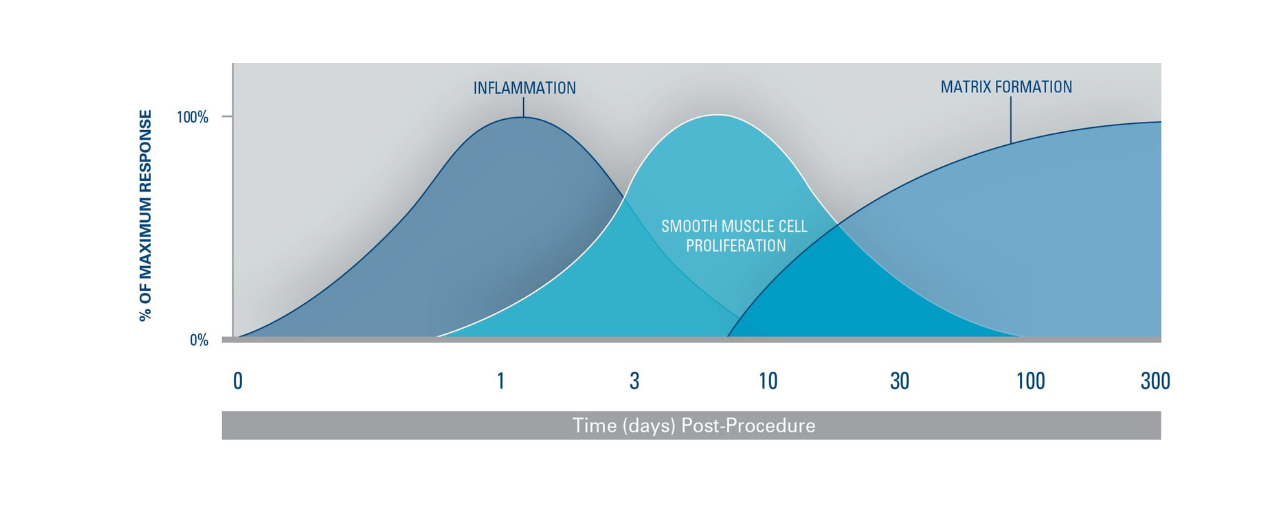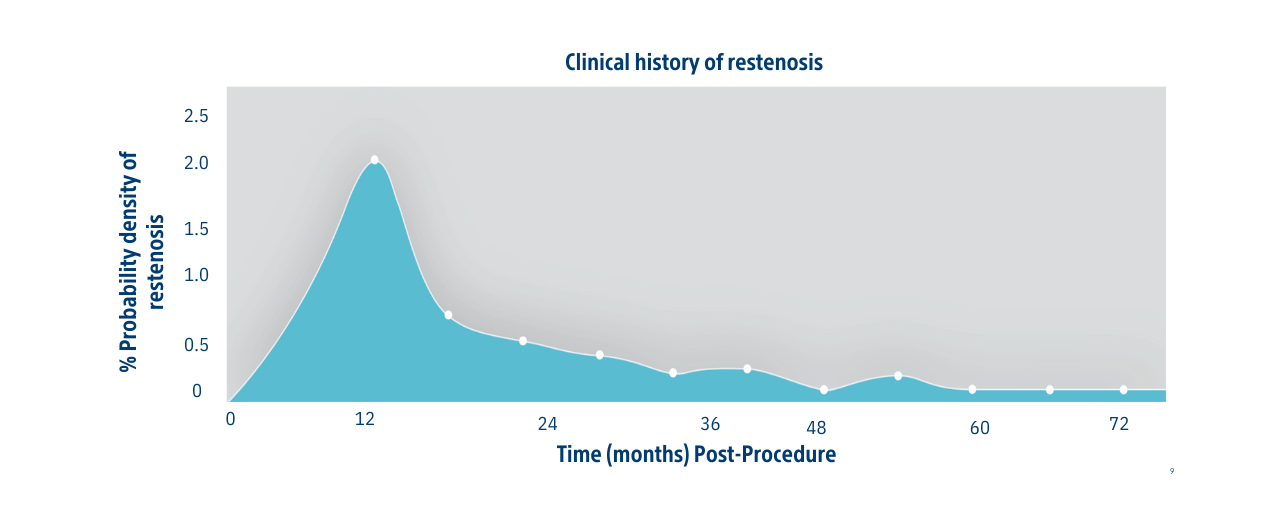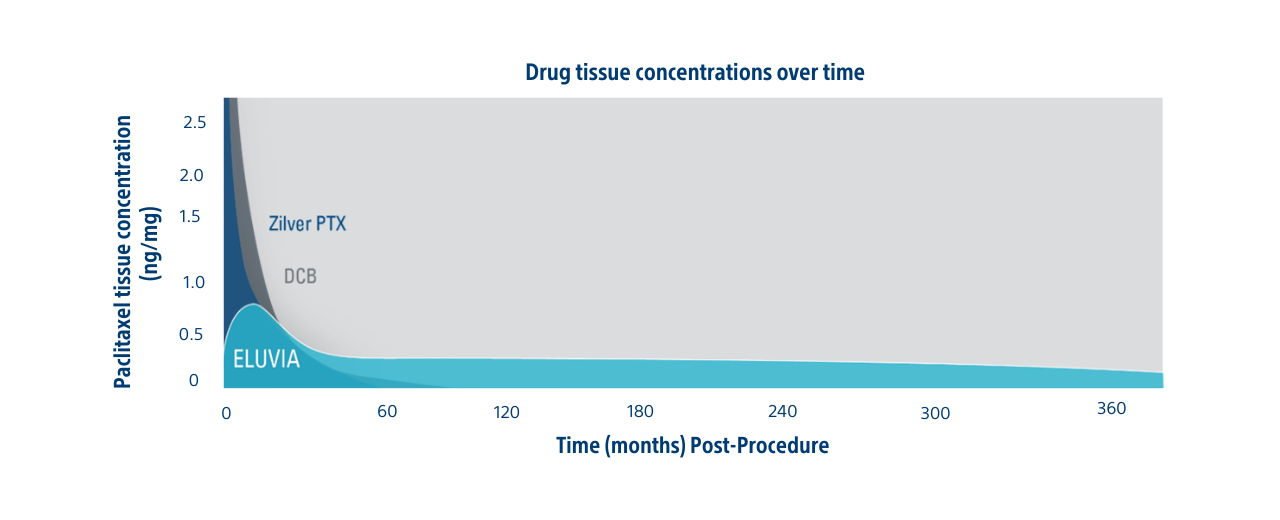Causes, risk factors and current treatments for restenosis
The endovascular management of peripheral vascular disease began nearly sixty years ago when percutaneous transluminal angioplasty (PTA) was first used[1]. The later addition of stenting resulted in even greater luminal diameter, however the success of the procedure was frequently limited by the development of restenosis[2,3]
Restenosis is a result of the general wound-healing response specific to vascular tissue where the section of blocked artery, which has been opened with angioplasty or a stent, narrows again[4].
The vascular biology of restenosis
There are three phases of wound healing (Figure 1)[5]:
- Inflammatory
- Granulation
- Matrix remodelling
Figure 1: The restenotic cascade: inflammatory, granulation and matrix remodelling[6]

Angioplasty or stenting causes endothelial injury due to mechanical stretching, rupture of the internal elastic lamina, and medial dissection. This stimulates myofibroblasts found in the tunica adventitia to produce a collagen-rich, extracellular matrix[7,8].
In addition, the injury results in exposure of collagen in the subintimal layers, von Willebrand factor, and the lipid core. This causes platelet activation, which in turn stimulates inflammatory mediators, such as growth factors. These attract vascular smooth muscle cells and fibroblasts to the area[9].
The start of the granulation phase is marked by the migration of local tissue cells into the wound site. The wound surface becomes covered by the migrating cells, which begin to synthesize new extracellular matrix components[10,11]. The vascular wall begins to thicken and there is loss of luminal patency[12]
Restenotic lesions are composed primarily of smooth muscle cells, proteoglycans, collagen and extracellular material[12,14]
Proliferation of smooth muscle cells following stent manipulation in the superficial femoral artery (SFA) may continue for up to 100 days or longer. Extracellular matrix formation can continue for beyond 300 days (Figure 1)[15].
The clinical history of restenosis post manipulation can continue up to 5 years[17] (Figure 2).
Figure 2: Clinical history of restenosis[18]

Treatments for restenosis
Although improvements in stent design have not eliminated restenosis, the use of antiproliferative treatment with drug-coated balloons (DCB) or drug eluting stents (DES) to disrupt cell division has produced more successful results[19].
Paclitaxel is a common component of DCB and DES. The use of paclitaxel as a component of DCB and DES is based on its antirestenotic, hydrophobic, and lipophilic properties. Paclitaxel acts by blocking microtubule disassembly by binding to the beta subunit of tubulin. This interrupts cell division by preventing cell progression from G2 to M, interfering with the mitotic spindle apparatus, and inhibiting smooth muscle migration and signal transduction[20]. The lipophilic properties of paclitaxel allow its absorption by the artery wall, where it decreases neointimal hyperplasia[21].
Drug-coated balloons, such as Ranger™ deliver the antiproliferative therapy in a single burst to the arterial wall at the time of intervention. The drug remains long enough in the tissue to have an impact on patency and reduce target lesion revascularizations (TLR)[22].
However, balloon-based drug delivery is unable to provide scaffolding for the artery, which is often required in long lesions or calcified femoropopliteal disease[23]. Drug-eluting stents combine the advantage of the mechanical scaffold of the stent with the antiproliferative effect of the drug[24].
Results using drug-eluting stents (DES)
In the Zilver PTX randomized trial, the self-expanding nitinol DES Zilver PTX (with polymer-free paclitaxel coating) was compared with the standard therapy of percutaneous transluminal coronary angioplasty (PTCA) and bare-metal stents. The study showed that Zilver PTX provided sustained safety and clinical durability compared with standard endovascular treatments, including significant reduction in target lesion revascularization (TLR) and significant improvement in long-term patency[25].
The advent of the DES, EluviaTM, has further evolved the delivery of antiproliferative therapy.
Eluvia is a revascularization device that provides sustained long-term drug release. Eluvia uses a novel combination of polymer and paclitaxel to release paclitaxel long-term - resulting in the continuing presence of paclitaxel at 12 months post procedure when restenosis tends to peak.
In the IMPERIAL randomized controlled trial, Eluvia was compared head-to-head with Zilver PTX[26]. Eluvia achieved a 50% reduction in the number of clinically-driven TLR at 24 months (Figure 2)[27].
The longer elution period of Eluvia compared with Zilver PTX (Figure 3) might contribute to the superior efficacy of Eluvia in the IMPERIAL trial[28].
A consistently low clinically-driven TLR at 2 years was also seen in challenging SFA lesions (including in diabetic patients), moderate or severely calcified lesions, chronic total occlusions and longer lesions[29].
Figure 3: Eluvia achieved 50% reduction rate in TLR vs Zilver PTX[30]

Figure 4: Eluvia's elution period compared with traditional drug-coated stents.
Based on pre-clinical PK analysis. Data on file at Boston-Scientific[31]

Do you have more questions about restenosis? Check out our FAQ >
Resources
[1] Payne MM. Charles Theodore Dotter. The father of intervention. Tex Heart Inst J 2001;28:28-38.
[2] Dieter RS, Laird JR. Overview of restenosis in peripheral arterial interventions. Endovasc Today 2004;36-8.
[3] Waugh J, Wagstaff AJ. The paclitaxel (TAXUS)-eluting stent: a review of its use in the management of de novo coronary artery lesions. Am J Cardiovasc Drugs 2004;4:257-68.
[4] Dieter & Laird, Overview.
[5] Forrester JS, Fishbein M, Helfant R, et al. A paradigm for restenosis based on cell biology: clues for the development of new preventive therapies. J Am Coll Cardiol 1991;17:758-69.
[6] Ibid.
[7] Ibid.
[8] Dieter & Laird, Overview.
[9] Ibid.
[10] Forrester et al., A paradigm.
[11] Dieter & Laird, Overview.
[12] Zain MA, Jamil RT, Siddiqui WJ. Neointimal Hyperplasia. [Updated 2022 Jan 25]. In: StatPearls [Internet]. Treasure Island (FL): StatPearls Publishing; 2022 Jan-. Available from: https://www.ncbi.nlm.nih.gov/books/NBK499893/
[13] Forrester et al., A paradigm.
[14] Dieter & Laird, Overview.
[15] Forrester et al., A paradigm.
[16] Ibid.
[17] Ibid.
[18] Ibid.
[19] Waugh & Wagstaff, The paclitaxel.
[20] Dieter & Laird, Overview.
[21] Müller-Hülsbeck S, Hopf-Jensen S, Keirse K, et al. Eluvia drug-eluting vascular stent system for the treatment of symptomatic femoropopliteal lesions. Future Cardiol 2018;14:207-13.
[22] Gray WA, Keirse K, Soga Y, Benko A, et al; IMPERIAL investigators. A polymer-coated, paclitaxel-eluting stent (Eluvia) versus a polymer-free, paclitaxel-coated stent (Zilver PTX) for endovascular femoropopliteal intervention (IMPERIAL): a randomised, non-inferiority trial. Lancet 2018;392:1541-51.
[23] Ibid.
[24] Lindquist J, Schramm K. Drug-eluting balloons and drug-eluting stents in the treatment of peripheral vascular disease. Semin Intervent Radiol 2018;35:443-52.
[25] Dake MD, Ansel GM, Jaff MR, et al. Durable clinical effectiveness with paclitaxel-eluting stents in the femoropopliteal artery: 5-year results of the Zilver PTX Randomized Trial. Circulation 2016;133:1472-83.
[26] Gray et al., IMPERIAL investigators.
[27] Müller-Hülsbeck S, Benko A, Soga Y, Fujihara M, Iida O, Babaev A, O'Connor D, Zeller T, Dulas DD, Diaz-Cartelle J, Gray WA. Two-Year Efficacy and Safety Results from the IMPERIAL Randomized Study of the Eluvia Polymer-Coated Drug-Eluting Stent and the Zilver PTX Polymer-free Drug-Coated Stent. Cardiovasc Intervent Radiol. 2021 Mar;44(3):368-375.
[28] Gray et al., IMPERIAL investigators.
[29] Müller-Hülsbeck et al., Two-Year Efficacy.
[30] Ibid.
[31] Dake MD, Van Alstine WG, et al. Polymer-free paclitaxel-coated Zilver PTX Stent–evaluation of pharmacokinetics and comparative safety in porcine arteries. J Vasc Interv Radiol 2011;22:603-10.
Caution:
The law restricts these devices to sale by or on the order of a physician. Indications, contraindications, warnings, and instructions for use can be found in the product labelling supplied with each device or at www.IFU-BSCI.com. Products shown for INFORMATION purposes only and may not be approved or for sale in certain countries. This material not intended for use in France.
















